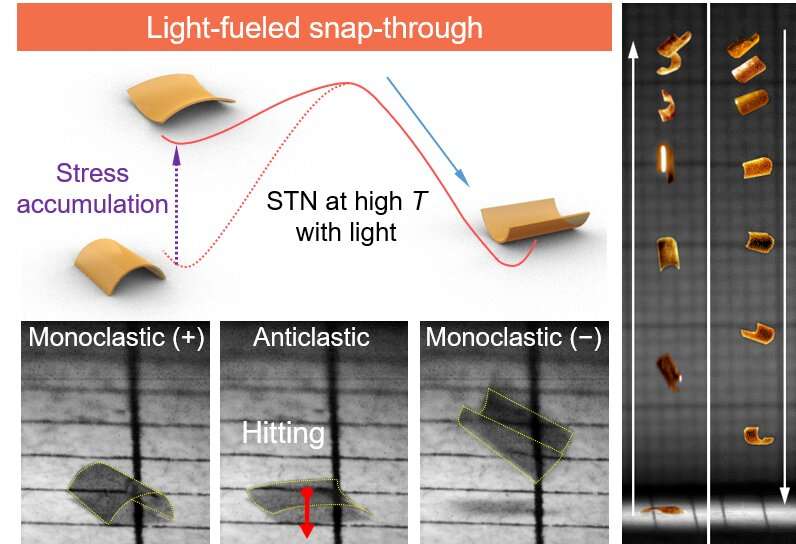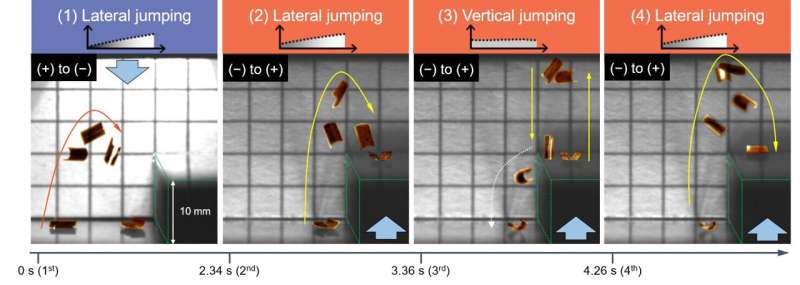The photo-induced bi-stable structure enables the photoactive liquid crystalline polymer to achieve snap-through inspired jumping. Effective photo-induced energy accumulation and release are induced by 270° super twisted nematic geometry of photoactive molecules. Credit: Inha University
Jumping movement is commonly observed in nature, including for mammals, insects and the other land creatures; this fluid motion aims for rapid mobility, a faster arrival time at a destination over large obstacles and rough terrain. The qualitative properties of the jump such as direction and height are regulated by mere fractions of potential and kinetic energy. In addition, an organism can opt to repeat its jumping motions as decided by its own free will.
To implement a similar type of jumping behavior into robotic systems, there must be tailored designs that generate an instant energy transfer to a substrate with sufficient accumulated energy. Many of the current jumping robots in the field adapt by kicking or pushing the substrates with their legs; this is commonly powered by motorized actuators or battery-powered systems. However, these systems add unwanted weight to the jumping robots and are also hard to fix onto a miniaturized body.
A photoactive liquid crystalline polymer is capable of jumping motion because the anisotropic photomechanical response of the photoactive molecular machine enables the liquid crystalline polymer to accumulate and release photo-induced energy effectively. The photoactive molecular machine, an azobenzene moiety, is aligned with liquid crystal molecules that provide directional photo-induced contraction from photoisomerization of the azobenzene. 270° super twisted nematic molecular geometry at top and bottom of the photoactive liquid crystalline polymer induces a non-isometric bi-stable state under actinic light irradiation with simultaneous heating. The bi-stable structure is known to accumulate energy below the energy barrier in order to deform between two stable structures. During the process of deformation, the accumulated energy begins to exceed the energy barrier and continues to an instant release, the so called 'snap-through.' Instantaneous energy release in photoactive liquid crystalline polymer generates the jumping motion through impact with the substrate. Remarkably, the maximum jumping height reaches 15.5 body lengths with the maximum instantaneous velocity of 880 BL s-1.
A formidable challenge for a jumping robot is on-demand continuous jumping. Unlike motorized jumping robots, it is difficult to implement continuous or directional jumping for a jumping robot with a monolithic body since the angle between the robot and actuation source changes continuously. The bidirectional light irradiation enables the photoactive liquid crystalline polymer to jump continuously in two different ways: hitting and kicking based photomechanical jumping. Regardless of the landing direction or curvature of the soft robot, on-demand light irradiation from top or bottom provide for jumping motions in soft robots.
The guided journey of photoactive liquid crystalline polymer by patterned light (one from top and another from bottom) for arrival at destination within seconds. Credit: Inha University
Additionally, the photomechanical jumping can be guided by generating a beam intensity gradient. The gradient light intensity breaks symmetry of photoisomerization in a monolithic photoactive liquid crystalline polymer which generates directionality of kinetic energy. By combining bi-directional light irradiation with a beam intensity gradient, the miniaturized photoactive liquid crystalline polymer can arrive at its destination, even overcoming large obstacles.
This unprecedent strategy will provide insights into contactless jumping maneuverability in miniaturized soft robots.
More information: Jisoo Jeon et al, Continuous and programmable photomechanical jumping of polymer monoliths, Materials Today (2021). DOI: 10.1016/j.mattod.2021.04.014
Journal information: Materials Today
Provided by Inha University

























